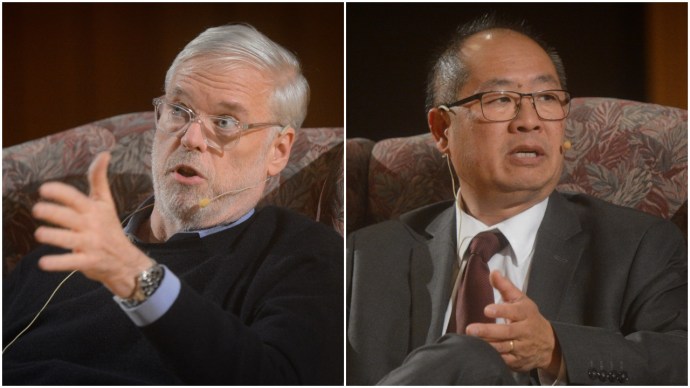LIRR President Phillip Eng and MTA Chairman Patrick Foye promised a more efficient MTA at Blank Slate Media’s “On the Record” forum last Thursday night, while underscoring the importance of new leadership and upgraded infrastructure.
The Metropolitan Transportation Authority, a public benefit corporation providing public transportation for downstate New York, has come under fire in recent years for everything from daily performance to late and costly projects like the East Side Access tunnel.
But this year has been “transformative and historic for the MTA,” Foye said, as the state Legislature passed congestion pricing, which is expected to generate $15 billion in revenue, and mandated reforms like undertaking a forensic audit and consolidating departments.
“The transformation plan will rapidly change and fundamentally change the face of the organization, the MTA, forever,” Foye said at the forum at the Unitarian Universalist Congregation at Shelter Rock in Manhasset.
Several agencies within the MTA will be consolidated, which Foye said will lead to considerable savings in time and money, and all projects above $25 million must now undergo a design-build process where designing and building firms team up and bid out their schedules.
The MTA board also approved a capital plan with a record $51.5 billion investment planned over five years, Foye said, which will include an “unprecedented” $5.7 billion for the Long Island Rail Road.
The $51.5 billion is paid for via congestion pricing, elimination of the internet tax advantage in New York City, a progressive tax, federal funding, $10 billion in borrowing and other revenue sources, Foye said.
Leonard Katz, a Great Neck resident, said that in years past the MTA would make similar presentations – but without results. He then asked how this situation would be different.
Foye said that the MTA has “had its share of failures and fiascos in the past,” but the MTA has a new team, a capital plan that will happen and successes to build on.
Among them are the early completion of the Double Track Project on the Ronkonkoma line, the Third Track expansion project between Hicksville and Floral Park remaining “on time and on budget,” and upgrades to the L train, he said.
Foye said both the Third Track and East Side Access projects are slated for completion by the end of 2022, which Eng noted could allow for up to 45 percent more capacity into Manhattan.
Eng said that more LIRR projects are also successfully being completed, in part thanks to the design-build process and quicker review.
He also said that on-time ratings have stayed over 92 percent, despite work being done throughout the system, and that ridership is expected to reach 91.3 riders – up 1.5 million from last year. Work has included switch and signal replacements, eliminating grade crossings, replacing low bridges and adding more tracks.
“We’re essentially eliminated delays that have plagued our system before,” Eng said.
Part of the capital plan includes more signal replacements, bringing several stations up to compliance with the Americans with Disabilities Act, or ADA, and studying the possibility of electrification through the system, including from Hicksville to Babylon, he said.
Eng and Foye were asked several questions by attendees, with topics ranging from Americans with Disabilities Act access to fare collection and parking.
One woman said the capital plan calls for about 70 subway stations to be made ADA accessible, but noted that there are more than 400 stations throughout the systems and called it a “drop in the bucket.”
Foye said the amount the agency is spending is one of the largest investments any public transportation entity has made to improve access. He also said there had been considerable outreach with disability rights advocates and more upgrades are likely in the next capital plan.
Karen Rubin, a Blank Slate Media columnist, said East Side Access would “dramatically increase” access into the city, but noted that parking lots – mainly owned by park districts and municipalities – are “already oversubscribed.” She then asked if the MTA had any potential solutions to the parking problem.
Eng said new parking garages are being built as part of the Third Track project, but some communities don’t want more parking structures. He said the agency has also met with NICE, bus companies and private entities to create shuttle services.
“It is a challenge across the system,” Eng said.
One woman also asked about air conditioning in Penn Station, describing the current situation as a “developing world kind of environment.”
Eng said Amtrak has provided cooled air as an interim solution, but air conditioning is in the capital plan for 2020.
Matthew Zeidman, a New Hyde Park resident, asked why the MTA chose to shorten the window to purchase monthly tickets. Eng replied that some people have illicitly procured tickets, so the agency decided to shorten the time frame to try countering that.
The full video of the event will be available online.

